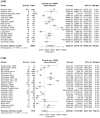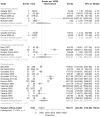Mountain sickness in altitude inhabitants of Latin America: A systematic review and meta-analysis
- PMID: 39316567
- PMCID: PMC11421813
- DOI: 10.1371/journal.pone.0305651
Mountain sickness in altitude inhabitants of Latin America: A systematic review and meta-analysis
Abstract
Objective: Chronic and acute mountain sickness is known worldwide, but most of the available information comes from the eastern continent (Himalayas) without taking into account the west which has the most recent group located at altitude, the Andes. The aim of this study was to synthesize the evidence on the prevalence of acute and chronic mountain sickness in Latin American countries (LATAM).
Methods: A systematic search of the variables of interest was performed until July 8, 2023 in the Web of Science, Scopus, PubMed and Embase databases. We included studies that assessed the prevalence of mountain sickness in high-altitude inhabitants (>1500 m.a.s.l) who lived in a place more than 12 months. These were analyzed by means of a meta-analysis of proportions. To assess sources of heterogeneity, subgroup analyses and sensitivity analyses were performed by including only studies with low risk of bias and excluding extreme values (0 or 10,000 ratio). PROSPERO (CRD42021286504).
Results: Thirty-nine cross-sectional studies (10,549 participants) met the inclusion criteria. We identified 5 334 and 2 945 events out of 10,000 with acute and chronic mountain sickness in LATAM countries. The most common physiological alteration was polycythemia (2,558 events), while cerebral edema was the less common (46 events). Clinical conditions were more prevalent at high altitudes for both types of MS.
Conclusion: Acute mountain sickness (AMS) occurs approximately in 5 out of 10 people at high altitude, while chronic mountain sickness (CMS) occurs in 3 out of 10. The most frequent physiological alteration was polycythemia and the least frequent was cerebral edema.
Copyright: © 2024 Zila-Velasque et al. This is an open access article distributed under the terms of the Creative Commons Attribution License, which permits unrestricted use, distribution, and reproduction in any medium, provided the original author and source are credited.
Conflict of interest statement
The authors have declared that no competing interests exist.
Figures






Similar articles
-
Disoriented and ataxic pilgrims: an epidemiological study of acute mountain sickness and high-altitude cerebral edema at a sacred lake at 4300 m in the Nepal Himalayas.Wilderness Environ Med. 2000 Summer;11(2):89-93. doi: 10.1580/1080-6032(2000)011[0089:daapae]2.3.co;2. Wilderness Environ Med. 2000. PMID: 10921358
-
Prevalence of acute mountain sickness in the Swiss Alps.BMJ. 1990 Oct 13;301(6756):853-5. doi: 10.1136/bmj.301.6756.853. BMJ. 1990. PMID: 2282425 Free PMC article.
-
Acute Mountain Sickness and High Altitude Cerebral Edema in Women: A Scoping Review-UIAA Medical Commission Recommendations.High Alt Med Biol. 2023 Dec;24(4):259-267. doi: 10.1089/ham.2023.0043. Epub 2023 Oct 23. High Alt Med Biol. 2023. PMID: 37870579
-
Sex-based differences in the prevalence of acute mountain sickness: a meta-analysis.Mil Med Res. 2019 Dec 9;6(1):38. doi: 10.1186/s40779-019-0228-3. Mil Med Res. 2019. PMID: 31813379 Free PMC article. Review.
-
Poor Knowledge of Acute Mountain Sickness in Latin American Medical Students.Wilderness Environ Med. 2022 Jun;33(2):148-153. doi: 10.1016/j.wem.2021.12.004. Epub 2022 Mar 28. Wilderness Environ Med. 2022. PMID: 35361528
Cited by
-
Prevalence of metabolic syndrome and its components according to altitude levels: a systematic review and meta-analysis.Sci Rep. 2024 Nov 11;14(1):27581. doi: 10.1038/s41598-024-77928-z. Sci Rep. 2024. PMID: 39528530 Free PMC article.
-
Exosomes from high-altitude cerebral edema patients induce cognitive dysfunction by altering oxidative stress responses in mice.Transl Psychiatry. 2025 Jul 22;15(1):253. doi: 10.1038/s41398-025-03469-2. Transl Psychiatry. 2025. PMID: 40695777 Free PMC article.
-
Neurological Manifestations Associated with Exercise at Altitude.Curr Neurol Neurosci Rep. 2025 Apr 9;25(1):29. doi: 10.1007/s11910-025-01418-6. Curr Neurol Neurosci Rep. 2025. PMID: 40202557 Review.
References
-
- Andes: World’s Longest Mountain Range | Live Science. Accessed September 20, 2023. https://www.livescience.com/27897-andes-mountains.html
Publication types
MeSH terms
LinkOut - more resources
Full Text Sources
Miscellaneous

